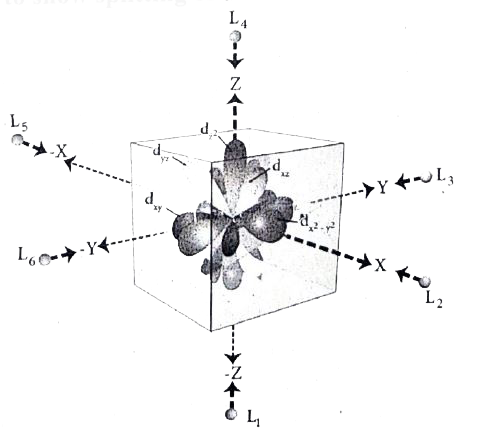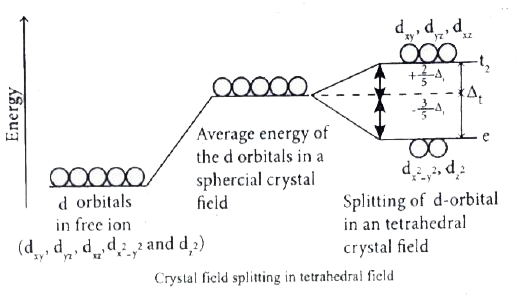Is an octahedral crystal field, draw the figure to show splitting of d orbitals .
Step 1 : In an isolated gaseous state, all the five d orbitals of the central metal ion are degenerate. Initially, the ligands form a spherical field of negative charge around the metal . In this filed, the energies of all the five d orbitals will increase due to the repulsion between the electrons of the metal and the ligand.
Step 2 : The ligands are approaching the metal atom in actual bond directions. To illustrate this let us consider an octahedral field, in which the central metal ion is located at the origin and the six ligands are coming from the +x, −x, +y, −y, +z and −z directions as shown below.
As shown in the figure, the orbitals lying along the axes dx2−y2 and dz2 orbitals will experience strong repulsion and raise in energy to a greater extent than the orbitals with lobes directed between the axes (dxy, dyz and dzx). Thus the degenerate d orbitals now split into two sets and the process is called crystal field splitting.

Step 3 : Up to this point the complex formation would not be favoured. However,when the ligands approach further, there will be an attraction between the negatively charged electron and the positively charfed metal ion, that results in a net decrease in energy. This decrease in energy in the driving force for the complex formation.
During crystal field splitting in octahedral field, in order to maintain the average energy of the orbitals (barycentre) constant, the energy of the orbitals dx2−y2 and dz2 (represented as eg orbitals) will increase by 3/5Δ0 while that of the other three orbitals dxy, dyz and dzx (represented as t2g orbitals) decrease by 2/5Δ0. Here , Δ0 represents the crystal field splitting energy in the octahedral field.

Related Playlists
- BOOK - FULL MARKSCHAPTER - COORDINATION CHEMISTRYEXERCISE - Additional Question(Choose the correct answer)76videos
COORDINATION CHEMISTRY
- BOOK - FULL MARKSCHAPTER - COORDINATION CHEMISTRYEXERCISE - Additional Question(Fill in the blanks)64videos
COORDINATION CHEMISTRY
- BOOK - FULL MARKSCHAPTER - COORDINATION CHEMISTRYEXERCISE - Additional Question(5 Marks Question)26videos
COORDINATION CHEMISTRY
- BOOK - FULL MARKSCHAPTER - CHEMISTRY IN EVERYDAY LIFE EXERCISE - ADDITIONAL QUESTION ( 5 Mark Questions )2videos
CHEMISTRY IN EVERYDAY LIFE
- BOOK - FULL MARKSCHAPTER - ELECTRO CHEMISTRYEXERCISE - ADDITIONAL QUESTIONS -5- MARK QUESTIONS15videos
ELECTRO CHEMISTRY
Similar Questions
In the octahedral crystal field, there is splitting of d orbitals. Which of the following d orbitals constitute the higher energy eg set of orbitals.
View SolutionIn tetrahedral crystal field, three is splitting of d orbitals. Which of the following d orbitals constitute the higher energy set of orbirals.
View SolutionIn an octahedral crystal field, the correct set of low orbitals are
View SolutionIn an octahedral crystal field, d - orbitals split into ….. Orbitals collectively called ….. And ….. Orbitals collectively called …..
View Solution(i) Discuss the nature of bonding in metal carbonyls.
(ii) Draw figure to show the splitting of d-orbitals in an octahedral crystal field and write electronic configuration of Mn2+ ion when:
(a) p>Δ∘
(b) Δ∘>pView SolutionIn a tetrahedral crystal field, the d-orbitals split into …… orbitals collectively called …… and …… orbitals collectively called ….. .
View SolutionDraw a sketch to show the splitting of d-orbitals in an octahedral crystal field. State for a d6 configuration, how the actual configuration of the split d-orbitals in an octahedral crystal field is decided by the relative values of Δ0 and P ?
View SolutionAmong the octahedral and tetrahedral crystal fields, In which case the magnitude of crystal field splitting is larger?
View SolutionAmong octahedral and tetrahedral crystal fields, in which case the magnitude of crystal field splitting is higher ?
View SolutionAmong the octahedral and tetrahedral crystal fields, In which case the magnitude of crystal field splitting is larger?
View Solution

